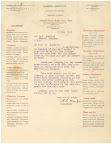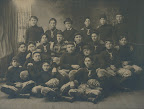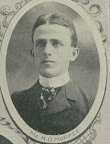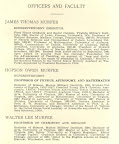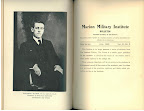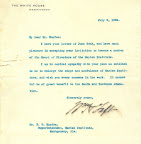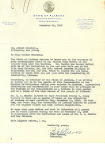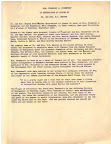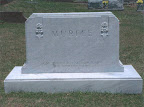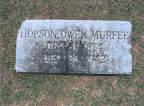What really struck me, however, was the fact that “Bloody Sunday” took place literally right out in front of the restaurant, and that The Glass House was witness to it all. It felt surreal sitting there eating my hamburger while reflecting on the brutal scenes I had witnessed as a kid unfolding on my television screen back in Huntsville, Alabama.
“Bloody Sunday,” March 7, 1965, was the first of three Selma marches in 1965 which marked the political and emotional peak of the U. S. Civil Rights Movement. The first march had its origins here in Marion, Alabama, when Jimmie Lee Jackson was shot by an Alabama State Trooper during a nighttime civil rights demonstration which erupted in violence near the Perry County Courthouse. Taken to Selma’s Good Samaritan Hospital, Jackson died eight days later from an infection resulting from the gunshot wound .

Grave of Jimmie Lee Jackson outside Marion, AL, on Highway 14 East. (Credit: MMI Archives)
In response, Civil Rights leaders in Selma called for a nonviolent protest march from Selma to Montgomery to confront Governor George C. Wallace. On March 7th, some 600 civil rights marchers, lead by John Lewis and Hosea Williams, and followed by Bob Mants and Albert Turner, Sr., of Marion, proceeded peaceably across Selma’s Edmund Pettus Bridge en route to Montgomery, only to find a wall of state troopers and local police awaiting them on the other side. The demonstrators were ordered to disband at once and go home. They stood quietly and awaited being arrested. Instead, donning gas masks and welding billy clubs, the state troopers moved in pushing the demonstrators backward and slashing at them with their clubs. Other troopers fired tear gas into the marchers, and mounted troopers charged into the melee which eventually pushed the demonstrators back across the bridge and back into the African American neighborhoods, the demonstrators being beaten and harassed along the way. Some seventeen demonstrators were hospitalized.
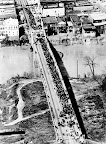
The Edmund Pettus Bridge (named for a Confederate general and later U. S. Senator) spanning the Alabama River at Selma, AL (third march, March 21, 1965). (Credit: New York World-Telegram and Sun Collection, Library of Congress)

The marchers, led by Hosea Williams and John Lewis, descending the bridge. (Credit: www.georgiaencyclopedia.org/nge/Multimedia.js...)

The troopers advance on the halted marchers. (Credit: www.artsjournal.com/man/2008/11/)

The police riot begins. John Lewis is being clubbed in the foreground. Haisten’s Mattress & Awning Company appears in the background. (Credit: www.wenjaz2.blogspot.com/)

The Haisten’s Mattress & Awning Company building today. (Credit: MMI Archives)

Tear gas is fired into the marchers. (Credit: Federal Bureau of Investigation photo)
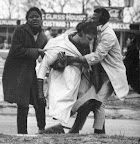
Helping the injured. The Glass House Restaurant appears in the background. Credit: http://medic.wikia.com/wiki/File:Selma6.jpg)

The Glass House today. The building in the right background is a former hamburger place that advertised 15-cent hamburgers in 1965. (Credit: MMI Archives)

John Lewis and other marchers being clubbed. In the background is the “15-cent Hamburgers” sign. (Credit: Encyclopedia of Alabama at http://www.encyclopediaofalabama.org/face/Article.jsp?id=h-1114)

The Glass House. To the lower rear of The Glass House sign is a square open metal sign atop a larger sign that read “15-cent Hamburgers” in 1965. To the right of that sign is the Edmund Pettus Bridge. (Credit: MMI Archives)

A close-up of the “15-cent Hamburgers” sign today (now Sammy’s Paint & Body Shop). (Credit: MMI Archives)
The horrifying scenes played out “live” on national and state-wide television, arousing mass support for the U. S. Civil Rights Movement, and naming the brutal day “Bloody Sunday.” A second march across the Edmund Pettus Bridge on March 9th, was largely a “ceremonial “ demonstration as it was pre-planned to halt on the other side due to a temporary restraining order issued by Federal District Court Judge Frank Johnson. The third march – the famous “Selma to Montgomery Voting Rights March” – began on March 21, 1965, and lasted five days and four nights covering a 54-mile route along U. S. Highway 80 (the “Jefferson Davis Highway” in Alabama) from Selma to the steps of the State Capitol Building in Montgomery. Here Dr. Martin Luther King, Jr., delivered his noted “How Long, Not Long” speech. President Lyndon B. Johnson, having witnessed “Bloody Sunday” on television - as millions of us did – enacted legislation which would become the Voting Rights Act of 1965. In a speech before Congress, Johnson even used the U. S. Civil Rights Movement’s most famous slogan, “We shall overcome.”

The third march: “The Selma to Montgomery Voting Rights March,” March 21 – 25, 1965. (Credit: James Karales/Duke University Special Collections Library)

Barack Obama, John Lewis, and Hillary and Bill Clinton crossing the Edmund Pettus Bridge during the March 4, 2007, commemoration of the historic Selma marches. (Credit: Scott Olson/Getty Images)
Photographs of “Bloody Sunday” reveal certain buildings in the background on U. S. Highway 80: The Glass House, Haisten’s Mattress and Awning to its right, and a hamburger place (“15-cent Hamburgers”) to the left of The Glass House - all three beside each other and facing the highway.
U. S. Highway 80 from Selma to Montgomery, AL, has been designated the Selma to Montgomery Voting Rights Trail, a U. S. National Historic Trail.
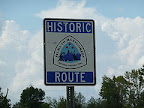
Selma to Montgomery National Historic Trail sign. (Credit: en.wikipedia.org/wiki/Selma_to_Montgomery_marches)
Finally, should you wish to watch scenes of “Bloody Sunday” on YouTube (from a special program on Alabama Governor George C. Wallace), check out http://www.youtube.com/watch?v=s00-OoZAWno.





